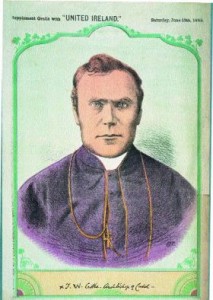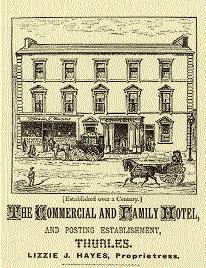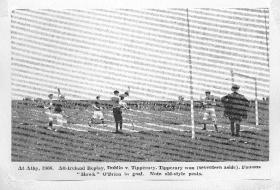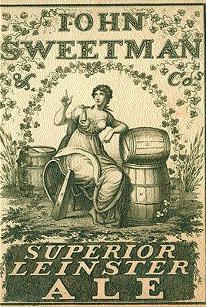Drink, Sunday School and the GAA: The use of documents in the teaching of history
Published in 18th-19th Century Social Perspectives, 18th–19th - Century History, Features, Issue 3 (Autumn 2004), Volume 12 Document 1: Section of a letter from Dr Croke, archbishop of Cashel, to the delegates attending the GAA convention at Thurles, 4 January 1888 (The Gael, 7 January 1888, National Library of Ireland).
Document 1: Section of a letter from Dr Croke, archbishop of Cashel, to the delegates attending the GAA convention at Thurles, 4 January 1888 (The Gael, 7 January 1888, National Library of Ireland).
To the delegates of the GAA in convention assembled at Thurles.
Gentlemen—I have no desire, gentlemen, nor have I a right, to interfere in any way with your deliberations, but it can hardly be said that I am entering on a province that does not belong to me as patron of your society if I venture to offer, as I do, a few facts for your consideration, and a few practical suggestions thereon. It has been frequently represented to me, and with special urgency of late, not alone from these and contiguous dioceses, and by priests, but from places far beyond the limits of Munster, and by thoughtful laymen, that the consumption of ardent spirits and other exciting drinks is greatly on the increase amongst the young men who are either competing members of the Gaelic Athletic Association or who come from a distance to witness their games. Unfortunately, I believe there can be no question as to the fact.
Secondly, I am assured on reliable authority that several of the young athletes who are engaged in Sunday sports, especially when they have to go a good way from home, habitually lose Mass in consequence; and that such sports possess so great an attraction now for a still more juvenile portion of our people, that instead of attending the catechism classes in church after late Mass, as they ought to do, they accompany their adult friends and neighbours to the hurling or football grounds, thus greatly displeasing their parents and doing no small injury to themselves. Hence, I would respectfully suggest that it be ruled somewhat as follows:
First, that the sale of porter and ale, and of course of all alcoholic drinks, be strictly prohibited on and, as far as possible, even near the field in which athletic sports are held.
Secondly, that in selecting the locality for such sports, the immediate neighbourhood of public-houses be specially avoided.
Thirdly, that no prizes be henceforth accepted from publicans, at least when there is good reason to believe, as there nearly always is, that they have offered them solely, or chiefly, with a view of attracting customers to their shops.
Fourthly, that no tournament, no county or district games, be held on Sundays or holidays of obligation (if that be at all practicable), and that even parochial or inter-parochial competitions be not begun on such days before two o’clock.
I have good reason to believe that the country at large expects you will substantially make such regulations as I now suggest; and I pray you, therefore, either now or at some future, but not distant time, to give them practical effect in your respective counties.
I have the honour to remain, gentlemen, your very faithful servant,
+ T. W. Croke, Archbishop of Cashel, The Palace, Thurles, January 4, 1888.
Background

Hayes’s Hotel, Thurles, Co. Tipperary, where the GAA was founded on 1 November 1884. (National Library of Ireland)
At the inaugural meeting of the GAA in Thurles on 1 November 1884, it was decided to invite Dr Croke, Charles Stewart Parnell and Michael Davitt to become patrons. All three accepted the honour. A strong supporter of the temperance movement, Croke devoted his letter to the GAA convention in January 1888 almost entirely to the issue of drink and the effect of the games on attendance at Sunday Mass and catechism classes. The official GAA journal, The Gael, published the text of Croke’s letter in its report on the convention.
Description and comprehension
In developing a degree of fluency in handling documentary evidence students need to learn how to recognise and describe various types of documents. The first step is to be able to classify a document, for instance as a letter, newspaper report, table, drawing, photograph or map. In addition, students should be able to identify certain features that are common to almost all documents: almost invariably a document has an author or creator, it has an addressee or a proposed readership or viewership, and it has a particular purpose. Other common features are a date of creation (known or unknown), a production process (handwriting, typewriting, printing, etc.), and an archival history (in private custody or in an archive or library).
The process of identifying these standard features might best be tackled by means of a class discussion led along by a series of questions such as: What class of document is this? Who created it? To whom was it addressed, or for whom was it intended? Why was it created, or what was its purpose? When was it created? How was it created and what were the stages involved in getting it to its present state or form? Where has it been preserved in the interim? The answers to the questions should enable students to write a formal description of the document, bringing it, as it were, to the stage where it can be presented as evidence. For classroom purposes, the answers to the questions should generally be apparent either from the document itself or from the background note; in the real world, however, the historian may not be able to answer all of these questions to his or her satisfaction, which may diminish the evidential value of the document.
It is important that students develop a sense of curiosity as to how things worked or would have been done in the past. In the case of the Croke letter, some discussion as to the possible scenario up to the point The Gael went on sale may be useful. Would Croke have written the letter by hand, typed it or dictated it to a secretary? Can one tell whether he posted it or had it delivered by hand? After it was read at the convention, would the GAA secretary have given it to the editor of The Gael or would Croke have sent a copy direct to ensure that it was published? Would he have wanted it to be published?
In relation to comprehension, the aim is to ensure that students identify and understand the main points of the letter. The best approach might be for the teacher to set specific questions regarding the main themes (Croke’s concerns and his proposed remedies) as the basis for individual written work; this could be followed by class discussion and a subsequent period in which students revise and rewrite their answers.
Interpretation
Having agreed the main content of the letter, the focus should be brought to bear on its value as historical evidence, which might best be teased out in open debate with subsequent written exercises. A crucial issue in the case of any document is its authenticity. In this instance there can be no doubt, as the letter was published and Croke would have publicly challenged any misrepresentation. Another line of approach would be the credibility and integrity of the writer. Is Croke honestly reporting the situation as he sees it? On what basis has he reached his conclusions? Who were his informants and can they be considered reliable? Would they be representative of the public at large or of a particular class or classes?
While we may take Croke’s concerns as genuine, is the situation regarding drink and attendance at Mass and catechism classes likely to have been as he states? Is he being reasonable or excessively alarmist? Would a present-day social historian set much store on the letter when researching the issues of drink or religious practices in the Ireland of the 1880s?
Wider context
One approach would be to relate the information regarding drink and attendance at Mass and catechism classes to the situation today. A particular issue would be the matter of sponsorship by the drink trade; a comparison of the system outlined by Croke with present practice and the possible implications of each might be worthwhile subjects for debate. Other areas worth discussing would be the reasons why catechism classes were held on Sundays; Croke’s right to call on the GAA to take action; and his obvious expectation that the Association would heed his appeal. In the context of the times how confident could he have been? Is it likely that the GAA took action along the lines suggested? If it did, what degree of success can it have had in the long term in respect of drink, attendance at Mass and catechism classes, or the scheduling and timing of matches? While the GAA is believed to have had considerable influence on Irish society, did it have influence in matters relating to morals or religious practice? Has the social role of the GAA, perhaps, been exaggerated in some respects?
Document 2: Photograph of the 1908 All-Ireland hurling final replay, Dublin v. Tipperary, at Athy, Co. Kildare, 27 June 1909 (Irish Press, GAA Supplement, 1934, National Library of Ireland).
 Background
Background
In the 1908 All-Ireland hurling final, Kickhams, winners of the Leinster championship, represented Dublin, while Thurles, winners of the Munster championship, represented Tipperary. For reasons mainly relating to scheduling the game was played the following year, in April 1909, at Jones’s Road, now Croke Park, resulting in a draw. The replay was held in Athy, where Tipperary won by 3-15 to 1-5. The game was reported in The Freeman’s Journal, which claimed that the day was fine and that there was a large attendance, going so far as to say: ‘it is possible that never in its history has the cosy little town of Athy held so many people as invaded it from every corner of Munster and Leinster. The special [train] from Dublin was well filled’. The game was not reported in The Tipperary People (Nenagh), which did, however, feature a report on a local match played the same day. Although it dates from 1909, the photograph is intended to represent in general terms what the scene would have been like at a major hurling match in the period 1884–91 with which the syllabus is concerned.
Description and comprehension
The class might formulate a description of the document through open discussion led by a series of questions such as: What class of document is this? Who might have taken the photograph? For what sort of viewership was it probably intended? For what purpose might it have been taken? When was it taken? Where has it been preserved? The ensuing description might run something like:
‘A black-and-white photograph of a scene at an All-Ireland hurling final at Athy taken by a person now unknown, probably a professional photographer, who may have intended to have it displayed or published. It was taken on 27 June 1909 and was reproduced in 1934 in the Irish Press GAA Supplement, a copy of which is held by the National Library of Ireland.’
In the case of many documents certain aspects may be unclear and need to be discussed. For instance, students need to be prompted into seeing the likelihood that the photograph was taken by a professional. The quality (composition, depth of field and the sharpness of the moving figures) suggests that this is so and that it is unlikely to have been a snapshot taken by an amateur. A related issue to which attention should be drawn is the screen effect on the image resulting from the process of printing in the newspaper, an effect that to some extent obscures the original high definition. Students should be shown how to differentiate between original photographs and printed items, which are generally recognisable from the screen or ‘golf-ball’ effect.
Having addressed the issue of describing the photograph as a whole, attention should be focused on the content. The various features should be noted and described in detail, one way of ensuring that nothing of consequence is missed being to divide the image into six squares and to concentrate on each one in turn. The main features to be noted and described are the parameters of the view; the action taking place; the number of players; their dress, headgear and footwear in so far as can be discerned; the hurleys; the perimeter railing; the condition of the pitch; the lining (liming) of the pitch; the style of posts; the umpire; the spectators; the skyline; and the weather. The description might perhaps be done as a written exercise followed by a discussion leading to a reappraisal and revision of individual findings.
Interpretation
In the absence of any evidence to the contrary the photograph can be accepted as an authentic record of the 1909 event. Its validity as evidence for hurling in the period 1884–91, however, is open to debate. The criterion is whether the individual details and the overall impact are generally compatible with what would have been the scene at a major hurling occasion in the early years of the GAA. References to various group photographs, newspaper reports and the GAA rules from the early period confirm that the main features of the photograph are indeed compatible. These include the worn state of the pitch, the style of play, the shape of hurley, dress and headgear, the style of posts, and the umpire. I think the photograph can be admitted as evidence with the caveat that it is not quite of the period but that it probably represents a fair approximation.
The reality is that while there are many GAA group photographs from the 1884–91 period, there are virtually no actuality views and this is about as good a visual representation of a hurling match of the period as one can get. A general point would be that historians (and forensic scientists) have to do the best they can with the available evidence, which all too often is fragmentary, inconclusive and tangential, and not relating directly in terms of time or place to the matter in hand.
The intentions of the photographer need some consideration. Presumably, he or she wished to provide a graphic and accurate record of a particular incident in the course of the game. It may have been taken for any of a number of reasons: as a personal souvenir, to give to a friend, to put on display in a hotel, pub or GAA club, or to publish in a newspaper. Whatever the motivation, the photograph can be regarded as an authentic and graphic record of the scene, and as typical of hurling matches in the early years of the GAA. By virtue of the rarity of such images from the period, it can be regarded as an important historical document. Once the photograph is admitted as evidence its quota of information can be analysed and assessed. The implications of the various features already mentioned all need to be discussed and debated.
Wider context

Contemporary advertisement for Sweetman’s ale. (National Library of Ireland)
The number of spectators is an issue that merits special attention. Considering the up-beat report in the Freeman’s Journal and the popularity of the game in that general period (allowing for some decline in the 1890s), there seem to be relatively few spectators. Possible explanations for the discrepancy may be that elevated ground with better viewing was available at other points or that the bulk of the attendance clustered nearer the entrance. One might also consider the matter of historical perspective; what was considered a large attendance in that period might be small by present-day standards. The Freeman’s Journal report tells of just one special train from Dublin, on the basis of which students might do a rough estimate of the possible number of Dublin supporters, taking into account the limited means of long-distance transport available at the time. The probable levels of attendance at national as opposed to local matches might also be considered in the context of contemporary travel facilities.
The most useful exercise for students would probably be to list features of the photograph that have changed over the years and those that have remained the same, and to consider possible reasons for the individual instances of change or continuity and their implications. Another exercise would be to do a graphic sketch of the scene as it might appear on a similar occasion today.
While the Department of Education encouraged the use of documents in the teaching of history for at least thirty years and made some limited provision for their use in the syllabus, the present initiative of document-based case studies is of major significance. It should give students new insights into the nature of history, the methods of the historian, the manner in which the accepted canon has evolved, and the value of debate, reappraisal and adjustment in the light of new evidence. It should prove of particular benefit for students who are considered less ‘academically inclined’, as they often turn out to be particularly astute when engaging with the more concrete and ‘real-life’ nature of historical documents, and can play a valuable and invigorating role in class discussion. Undoubtedly, those teachers who have already used documents for many years welcome the new syllabus, but for everybody, students and teachers alike, it poses an opportunity rather than a threat, and should provide a positive boost for the study and teaching of history at second level.
Noel Kissane was Education Officer of the National Library from 1975 to 1995 and published over a dozen collections of documents for use in schools, including The Land War (1976), The GAA (1984), Parnell: a documentary history (1991), and The Irish Famine: a documentary history (1995).
Acknowledgements
Illustrations are from the National Library of Ireland, courtesy of Joanna Finegan, Sandra McDermott and Dónall Ó Luanaigh; thanks also to John Dredge, Dymphna Moore and Gerard Lyne for comments on the text.
















